Born in Ensenada of Debated Origins
By Chris Mejia
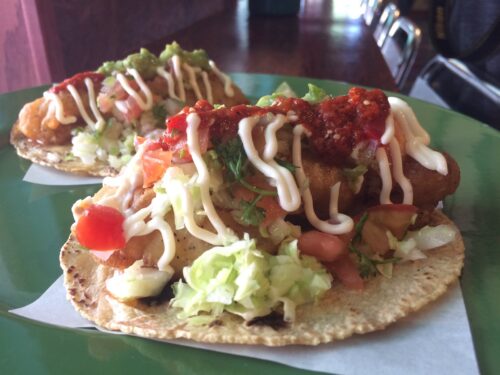
Arguably the only of Mexico’s tacos whose origin can be legitimately claimed by the northern coastal state of Baja California, the exact genesis of the iconic battered-and-fried fish taco is something of local lore, and often fiercely debated by food historians and locals alike. While most Mexicans credit Ensenada as the undisputed birthplace of modern fish tacos, at least two principal origin stories exist. Rather than argue which is more authentic, let’s examine the top two tales and allow you, the reader, to decide which fish taco religion to adopt…
The Japanese Fishing Connection (1930s-1950s):
Drawn by the cold fertile Pacific waters off Baja California’s northern coast, as early as 1918, entrepreneurial Japanese fishermen started migrating to the Mexican port town of Ensenada. The first Japanese settlers were skilled abalone divers who took advantage of their diving expertise to establish a market for abalone from Mexican and Southern Californian waters, where virtually no market existed before their arrival. By the early 1930s, there were so many Japanese in Ensenada, the “Asociaion Japonesa de Ensenada” (in English: Japanese Association of Ensenada) was formed to assist “Issei” (first generation Japanese migrant) farmers, abalone divers, fishermen, merchants, and their families as they settled into their new Mexican immigrant lives.
By the late 1930s, Japanese immigrants in Baja California led the northern Mexican fishing industry, as thriving business owners and local captains of commerce. That all came to a sudden end, when on December 7th, 1941, the Japanese navy launched a surprise attack on the U.S. naval fleet in Pearl Harbor, Hawaii, catapulting the formerly reluctant United States into World War II. To the U.S. government, fishermen were the most dangerous group among all Japanese immigrants in the Americas, principally because they knew the coasts from Canada down to the southern tip of Baja California, and this posed a threat of strategic intelligence. At the request of the U.S., Mexican officials ordered all Japanese immigrants to camps located in Guadalajara and Mexico City, where they lived throughout the duration of the War, from 1941 to 1946. While the suddenly relocated Japanese immigrants certainly suffered the ill effects of forced relocation and leaving their businesses and homes behind, at least they were able to live relatively free (compared to those held in American Internment Camps) in Guadalajara and Mexico City where they struggled to establish new businesses and make the best of their terrible fate. By the end of the War, less than half of the relocated Japanese immigrants decided to return to Ensenada, where in the interim, the Mexican fishing industry had languished during the war without the Japanese.
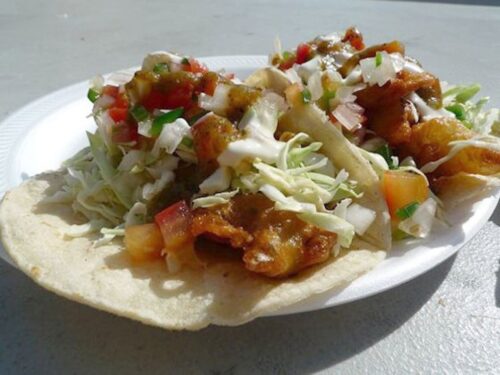
Some Ensenada locals and many Americans postulate that the modern battered-and-fried fish taco is a fusion of Japanese gastronomy and Mexican street food that originated in Ensenada sometime between the 1930s and 1950s. It’s said that the Japanese fishermen introduced the Japanese cooking style of tempura to the Mexicans, who adapted this battered-and-fried cooking method using local ingredients (e.g., trading wheat flour for rice flour) and wrapped the breaded fish in corn tortillas.
As the story goes, the Japanese fishermen would come into port with their haul at the end of the day (mid-day to early afternoon), and once offloaded, would head thirsty for the local saloons to drink whiskey. As they headed into town on foot, they would pass right by the taco carts waiting nearby the harbor for the fleet to return, turning their noses up at the foreign-to-them meat taco offerings. Irritated, and noting that many Japanese fishermen preferred to drink American or English whiskey instead of Tequila, and with the cost of imported whiskey being much higher than Tequila, the Mexican taqueros (in English: taco makers) realized that these Japanese fishermen must have been wealthier than their Mexican fishermen counterparts. Despite not speaking a word of Japanese, one enterprising taquero is said to have befriended some of the Japanese fishermen and was eventually invited to their fish camp on the beach for dinner… where he was served, fish tempura. Watching the Japanese fishermen eat up the fried-and-battered fish, the intrepid taquero decided he would try to perfect the recipe himself, in hopes that he could sell his version to the Japanese fisherman at the end of their workdays. After many rounds of experimentation, he decided that he had finally perfected the dish, and decided to offer it, served over rice with soy sauce, from his taco cart. Legend has it that the Japanese fishermen who had once snubbed all the taco stands, started lining up for his, and when the other Mexicans became curious, he served the battered-and-fried fish to them as a taco, on a corn tortilla instead of over rice. And so, they say, the fish taco was born.
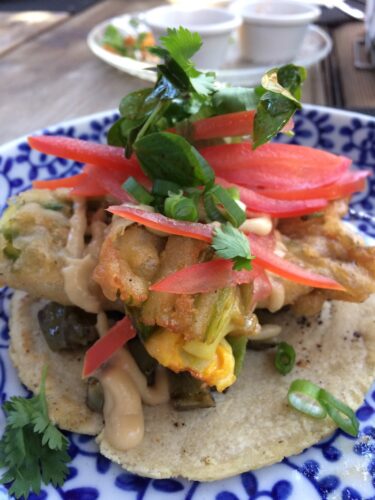
El Mercado Negro (1950s-1960s):
Contrary to the Japanese tempura theory, some Ensenada locals and historians credit the first fish tacos to a crusty native of Sinaloa, and Ensenada transplant, named Mario (surname unknown). Affectionally known by the nickname “El Bachigualato”, it’s said that Mario pioneered the original fish taco at his small stand inside the Mercado Negro (in English: black market) sometime in the late 1950s. Mercado Negro — a portside fish market comprised of individual stands that originally specialized in selling illegally caught lobster, abalone, and shrimp along with various other fish varieties — first operated from 1957 to 1967. Mexican authorities closed the market and evicted all tenants, including El Bachigualato, in 1967 due to complaints of late-night debauchery, but it was later reopened legally with new tenants and is still in operation today.
Before cooking fish tacos, Mario specialized in selling meat tacos where he grilled the meat wrapped in foil over an open wood fire. At some point, one of the vendors of the fish market asked Mario if he could also prepare some fish in the same way he cooked the meat for his tacos. Mario obliged, and some claim the original Baja fish taco was born from Mario’s little rustic stand inside of Mercado Negro. It’s notable that El Bachigualato’s creation was grilled, not battered-and-fried. He served his grilled fish tacos on corn tortillas with a “salsa bandera” topping (in English: flag salsa, also known as “Pico de Gallo,” is called “salsa bandera” because the colors of the tomato, onion, and cilantro used to make it are the same red, white, and green of the Mexican flag). It’s said that Mario utilized the white, tender, and boneless flesh of Angel Sharks to make his fish tacos, as these fish were plentiful and often discarded on the beach by fishermen who could find no market for the small sharks.
Even as his fame for fish tacos grew locally and with tourists visiting the market from nearby Tijuana, Mario didn’t always open his stand, falling ill to the bottle on a regular but erratic basis. Witnessing patrons disappointed by his unpredictable absences, other taco vendors in the market started selling their own tacos of fish. One of those was Zeferino Mancilla Fortune, a mainlander transplant to Ensenada who had found work in the local fishing trade before going into business with his wife selling tacos in Mercado Negro. Don Zeferino worked at perfecting Mario’s creation and experimented with flouring his fish before cooking to keep it from sticking to the foil. From there, he and his wife eventually abandoned the foil cooking method altogether in favor of pan frying in oil, and then eventually battered the pieces of shark before frying. Don Zeferino added finely shredded cabbage as a topping and served his battered-and-fried fish tacos with salsa bandera.
In 1963, having fallen chronically ill to the effects of alcoholism, El Bachigualato gave his stand to a friend, Mrs. Socorro Negrete Rivera. Doña Socorro operated Mario’s stand inside Mercado Negro for four more years, until she was evicted by the government officials in 1967 along with all the other market vendors. Shortly thereafter, she crossed the Peninsula and went to live in San Felipe (on the Sea of Cortez), where she continued making fish tacos, becoming a pioneer of the fish taco in that port. It’s notable that the U.S. fast casual food chain, Rubio’s Coastal Grill (originally named “Rubio’s Fish Tacos”), was inspired by a college spring break trip to San Felipe in the 1970s.
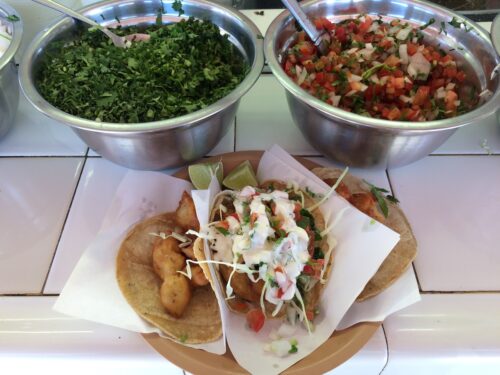
Ordering and Eating Fish Tacos
No matter which origin story you decide to adopt (and perhaps the truth lies somewhere in the middle), you’ll probably agree that Baja fish tacos are one of Mexico’s most delicious taco offerings. While you can find decent Ensenada-style fish tacos north of the border (mostly in Southern California), for the freshest and best fish tacos, you’ll need to grab your passport and head south.
With rare exception, the best fish tacos in Baja California are served before 1pm; the earlier the better. Many of the top stands and carts sell out of fresh fish by the early afternoon, electing not to replenish until the next day’s delivery (this ensures freshness, and that’s a very good thing). Accordingly, foreigners are usually surprised to learn that fish tacos are considered a breakfast food by locals.
You’ll find that some vendors sell their fish tacos “naked,” just 2-3 pieces of fried fish (usually shark) served on a tortilla, with all the usual condiments available to customers for a “build-your-own” dining experience. If this is what you encounter, it’s suggested that you first add a generous squeeze of lime directly onto the battered fish, then load the taco with shredded cabbage, salsa bandera (don’t worry, it’s not spicy), crema (a mayonnaise and lime white sauce which is an essential part of the modern Baja fish taco), pickled red onions, and green avocado salsa (this salsa is usually very spicy, so go easy at first). You’ll eat your share of tacos before paying, so keep track of your own count, as paying on the honor system after you dine is customary at taco stands throughout Mexico.
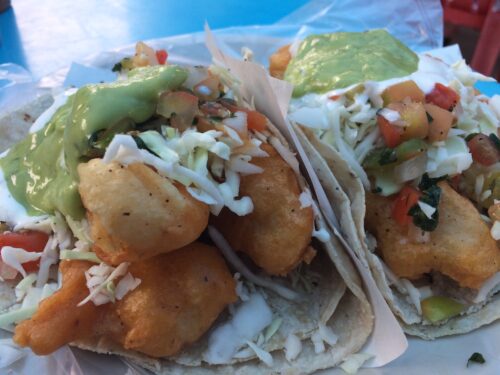
A few of my favorite fish taco joints in Baja California:
- “Erizo” located in Tijuana’s swanky Chapultepec district is the upscale yet casual seafood restaurant from famed Baja celebrity chef, Javier Plascencia. You’ll pay a bit more for upscale versions of the iconic Baja street style fish tacos, but dining is tableside with waiters for those looking for a fun new date place. Indoor paid parking is easily available at the big shopping mall located on the same street, about a block or so away.
- “Mariscos Titos” in Playas de Rosarito is known for their massive (overloaded) fish tacos, located under a big blue tent just East of Highway-1 near the big Soriana grocery store and directly across from City Hall. You’ll eat on picnic benches in a very casual, yet festive atmosphere. Parking is free in their dirt lot, but don’t forget to tip the attendant who watches over your vehicles while you dine inside.
- “El Trailero” is located in North Ensenada on the east side of Highway-1; as you are approaching town from the North heading South, you’ll need to make a U-turn after passing the restaurant and then immediately enter the frontage road on your right. This famous roadside truck stop taqueria features a variety of Baja’s best tacos, all excellent, so be sure to go hungry if you are going to sample more than fish tacos; street parking in front, or lot parking in the rear are free; generally considered a safe area.
- “Tacos El Muelle”, aka “Tony’s Fish Tacos” is a food truck located in a parking lot just off the main drag in Guerrero Negro (just over the border into the state of Baja California Sur), about halfway into town on your right if you’re headed into town from Highway-1. There are no restrooms at this famous pit stop, so be sure to use the facilities at one of the gas stations when entering town.
- “Tacos El Estadio” in LaPaz, Baja California Sur, is located at the intersection of Independencia and Guillermo Prieto in a rather non-descript but generally safe residential neighborhood of LaPaz. Specializing only in fish tacos, and thus closing early (whenever the fish runs out each day), this local’s favorite taco stand is not near the Malecón or downtown tourist areas, but it’s not too far away for arguably the best fish tacos in LaPaz, if not all of Baja California Sur. You’ll likely want to drive to this stand, and street parking is usually easy to find within a block or so of the restaurant.
Chris Mejia is an experienced culinary guide, food writer, and self-proclaimed “gastronomer” who has spent years exploring and curating the best of Baja California’s vibrant food scene. Follow Chris on Instagram and Facebook @MrStretchyPants.

It’s all well and good but the best fish tacos are in San Felipe along the Malecon.
Chris, good and tasty article. You are probably young to know that Tacos El Fenix has been around for way more than 50 years. Still there, except they moved the stand to the other side of the street many years ago. I could alway know where they were due to the pinturas Corona store at the corner.
My wife and I had the unique opportunity to enjoy El Fenix tacos twice last week, once on our way dow to the San Pedro Martir National Park and again on our way back. Stayed fine nights camping between huge pine trees and beautiful aspen trees, good hiking hardly any one else around and Stayed at the Rancho Maling on our way up where we enjoyed the pool and delicious food. El Fenix now has parking and clean bathrooms. You must try them sometime!